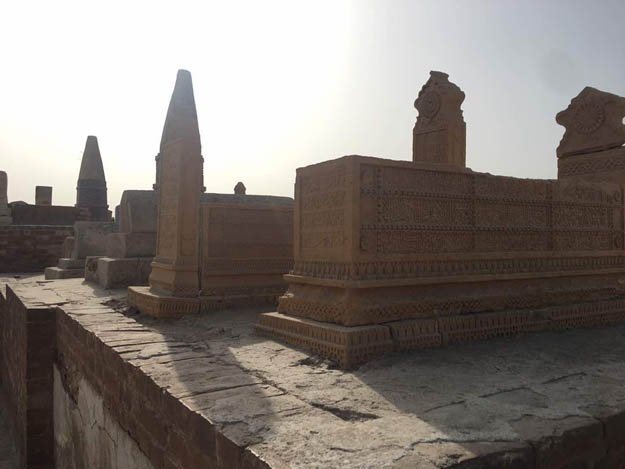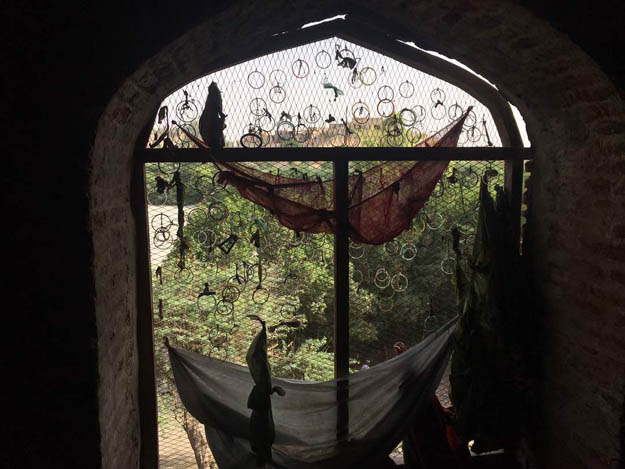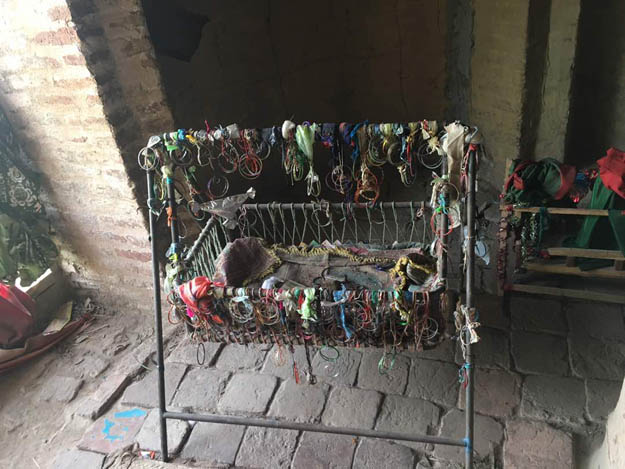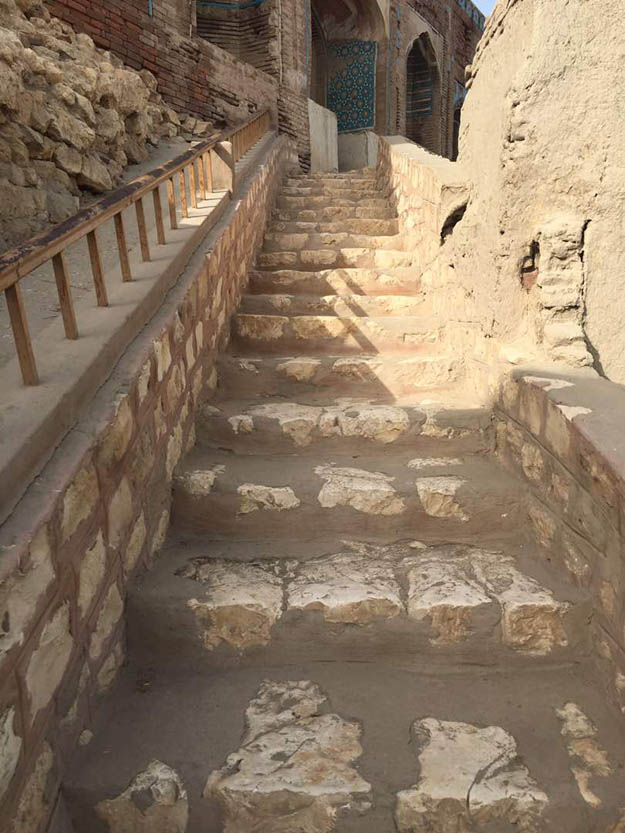
Located on the left bank of the Indus River near Lansdowne Bridge in Rohri, Satiyan Jo Aastan is the resting place of the fabled seven sisters. It is said that the sisters came to Sindh with the convoy of Muhammad Bin Qasim around 1,300 years ago. Satiyan Jo Aastan, which can be translated as the abode of the seven sisters, is situated in a cave in a muddle hill beside the Indus River. The shrine was constructed later. Thirty stairs lead up the hill into the cave that consists of an uneven path and five balconies.
 The shrine boasts dozens of bangles tied to window grills. PHOTO: YUSRA SALIM/EXPRESS
The shrine boasts dozens of bangles tied to window grills. PHOTO: YUSRA SALIM/EXPRESSThere are several myths and stories related to the sisters; some say they were seven friends but the most popular tale is that they were seven sisters who chose this hill as their home. Their lives were disrupted when Raja Dahir, the Hindu ruler of Sukkur, which was then known as Bakhar, caught a glimpse of the women and ordered his slaves to bring them to him. In order to protect their honour, the sisters prayed while sitting on the hill to save their lives and protect them. It is said that while the women were on their knees, heads bowed in prayer, the hill sucked them inside and since then the place has been considered a sacred site.
Sakhi Sarwar: A saint revered by Muslims, Sikhs and Hindus alike
The caves and shrine are just above the place where the sisters were said to have knelt down to pray. "No males are allowed to go inside the caves, as the sisters were unmarried and pure," said the caretaker Imdad Ali. "Now it is our responsibility to protect the paak bibiyan [pure mistresses]".
Satiyan Jo Aastan is a special place for the women who go to pray there. Women congregate at the shrine from across Sindh, Balochistan and even Punjab.
 Many female devotees visit the shrine to pray for daughters. PHOTO: YUSRA SALIM/EXPRESS
Many female devotees visit the shrine to pray for daughters. PHOTO: YUSRA SALIM/EXPRESS"I have three sons and have come to paak bibiyan to pray for a daughter this time," said Naseem Begum, who belongs to Multan but heard about seven sisters from a relative who lives in Khairpur.
Sitting on the floor of the cave, Ruby Ali was reading the Holy Quran while her two-year-old daughter wandered about the cave, examining her surroundings in wonder. Bangles of different colours tied with cloth to a cradle, bangles tied with thin pieces of cloth to a window grill and cradles made of cloth are common sights at all five of the cave’s balconies.
"I have eight children and Aasiya is my only daughter," shared Ruby. She said she has been visiting Satiyan Jo Aastan since she was a child. Once upon a time her mother came to pray at the shrine for Ruby’s birth. She also came to pray for the birth of her own daughter. "I will keep coming here till my last breath and will ask my daughter to continue this practice," she vowed.
Female faith healer arrested for selling infant
At the top of the caves lie some intricately designed graves, some of are huge and prominent. "The largest one belongs to Abul Qasim Namkin, who was the amir of Bhakkar," explained a local resident, adding that Namkin’s whole family are buried here. The caretaker of Satiyan Jo Aastan said one of Mughal emperor Akbar’s governor’s graves is also here.
 There are 30 steps leading up the hill to the cave that houses the shrine. PHOTO: YUSRA SALIM/EXPRESS
There are 30 steps leading up the hill to the cave that houses the shrine. PHOTO: YUSRA SALIM/EXPRESSThe hill that supposedly engulfed the women all those years ago was made their final resting place around 425 years ago. Major repair work was done on the shrine between 2000 and 2001 when Kaleemullah Lashari was the deputy commissioner of the area.
The place does not get any funding for repairs or maintenance but many devotees donate money and food to the caretaker who has been there since 1990. "I do not get any salary but manage from the money any devotees donate," said Imdad, adding that some bring food while some bring sweets when their vows are fulfilled.


1732225542-0/logan-(1)1732225542-0-165x106.webp)














COMMENTS
Comments are moderated and generally will be posted if they are on-topic and not abusive.
For more information, please see our Comments FAQ